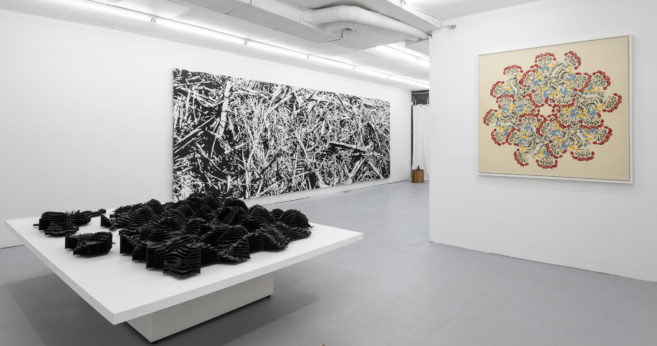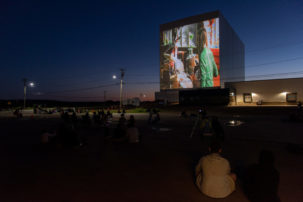Washed with sepia tones, a self-portrait of Meryl McMaster gazes from the white gallery walls of Pierre-François Ouellette Art Contemporain onto the street, surveying and challenging passers-by. Ancestral (2008) and Second Self (2010), two bodies of work from McMaster’s early career, demonstrate her interest in the dilemmas of representation and challenge the core of the traditions of portraiture. McMaster has since been working to expand her approach to photography by layering narrative, costume-design and sculptural elements to stage complex and fantastical scenes.
For the Second Self series, the artist asked her sitters to conduct automatic contour self-portraits, which inspired the wire masks she created to affix to each person. Her technique seems to attempt representation beyond the limits of physical perception and likeness: around their white-painted faces, the wire sculptures emphasize the sitter’s psyche, spirituality or consciously constructed personas. The apparatus of the wire mask, in tandem with the painted, ghost-white sitter, challenges us to think about what is sacrificed from one’s interiority to the surface of a static image.
In the portraits of the Ancestral series, both McMaster’s and her father’s faces are adorned with projections of archival, anthropological images. By wearing exoticized photographs like a mask upon the contemporary Indigenous body, the series troubles the romantic tropes perpetuated by Euro-American artists such as Edward Curtis or George Catlin. Some of the photographs in the Ancestral series morph the sitters beyond human form, transforming the image of McMaster’s father into that of an animal, like a Cougar or an Eagle. McMaster displays a command of the medium of portrait photography by emphasizing the slippages of representation through the addition of simple screens on her sitters. A keen eye will follow the misalignment and overlapping features of the archival image and sitter. These inconsistencies ruin the fantasy of representation and demonstrate the shortcomings of both the original reference and contemporary modes of portraiture.
Both bodies of work masterfully highlight the pitfalls of representation and portraiture: Ancestral brings generations past into the present and Second Self goes below the surface of the picture plane to illuminate the complexities of personality.







